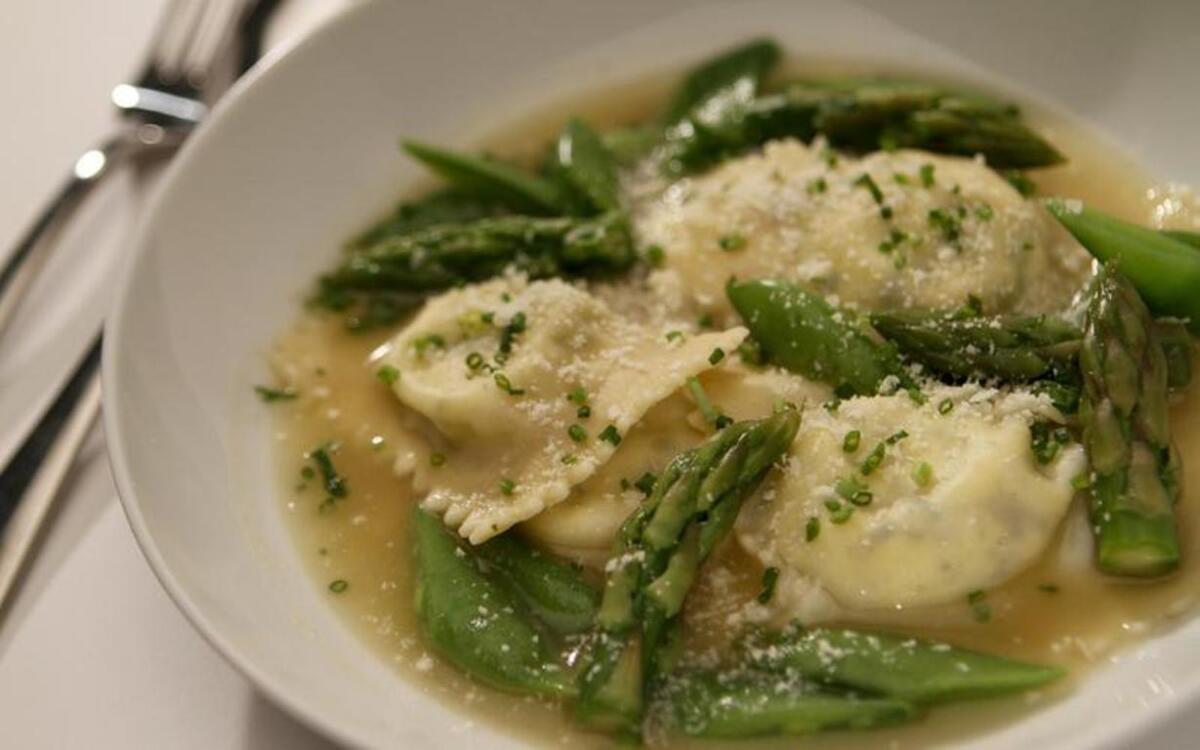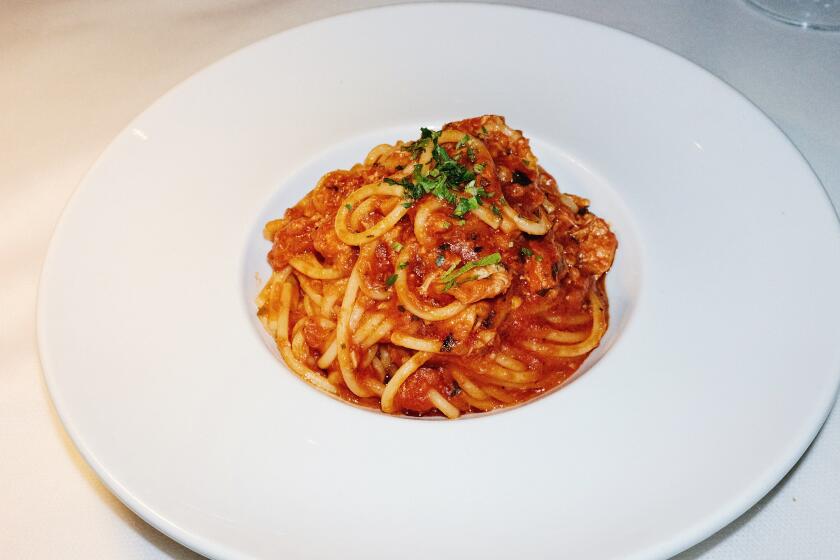Spring vegetables in Parmesan broth with goat cheese ravioli

- Share via
Here in California we love to brag about our abundance of wonderful seasonal ingredients and how that makes good food easy. That’s more or less true, but I have to confess that I’ve also always had a sneaking admiration for those cooks who can whip up something from nothing.
Sure, it’s wonderful to be able to just pick up a sack of Ojai Pixie mandarins and a box of medjool dates and call it dessert. But you’ve really got to admire someone who can take a couple of wilted zucchinis, a sprouting onion and some canned tomatoes and turn that into something delicious -- the real-life equivalent of the proverbial stone soup.
I’ve got my own version, and, in fact, it does start with something hard as a rock. In a battered plastic bag in the deepest recesses of my refrigerator, I’ve got a hidden stash of gold: rinds from used chunks of Parmigiano-Reggiano. Whenever my wife finds them, she pulls them out and asks disbelievingly: “You’re saving these?” And probably 98% of people would have the same reaction.
But those rock-hard rinds are flavor bombs, packed with umami. Simmer them in a pot of beans, in a soup, even in a tomato sauce, and you probably won’t actually taste Parmesan, but you’ll certainly taste the difference.
Those rinds can also take on a more starring role. One of the trending preparations in restaurants right now is Parmesan broth -- at its essence, simmered Parmesan rinds. It makes a wonderful light sauce with a subtle nutty, buttery flavor that serves as a complementary backdrop to all kinds of spring dishes.
There’s a little more to it than simply boiling rinds, of course. I start mine with a combination of chicken broth and water -- half and half is a good starting point. Most canned stocks and broths are better appreciated for the flavors they imply rather than the ones they actually possess. And in this case, even a good homemade stock would be too strong by itself. You want to taste the cheese, not the chicken.
With that I simmer some sliced garlic and a handful of whatever herb trimmings I have from prepping the other ingredients. Again, this is an Italian-style broth, meant to be subtle.
It’s not quite something from nothing, but it comes pretty close.
Parmesan broth
The best thing I’ve made with Parmesan broth recently was a kind of cross between a stew and a pasta that paired goat cheese ravioli and spring vegetables. I used asparagus tips and sugar snap peas for this recipe, but I’ve also made similar dishes with English peas, fava beans, shaved radishes and even bolted lettuce from the garden.
The only part that’s even a little tricky is making the ravioli. If that intimidates you (and it shouldn’t ... it takes less than an hour of work and it’s actually really fun), you could substitute quadrati -- little fresh pasta squares; make them beautiful by including leaves of fresh herbs on the last turn of the dough.
Gnocchi would work too, but if you insist on dried pasta, use tiny orzo or stelline. This dish emphasizes delicacy; any of the chewier shapes would be out of sync. Cook them separately so they don’t cloud the broth.
Most everything can be prepared in advance, so only a few minutes of cooking are needed just before serving. Make the Parmesan broth and the goat cheese ravioli. Prepare and blanch the vegetables.
Then at the last minute reheat the broth and bring a wide pot of water to a boil. Cook the ravioli and divide it among warm pasta bowls. Reheat the blanched vegetables in the same water and arrange them over the ravioli. Ladle over some broth and sprinkle with chopped chives and a little grated Parmesan to finish.
In a soup pot, simmer the chicken broth, water, garlic, Parmesan rinds and herb trimmings until aromatic and flavorful, about 90 minutes. Strain and return to the soup pot.
In a wide pot, blanch the asparagus tips in plenty of rapidly boiling, generously salted water until just tender, about 3 minutes. Use a wire skimmer or slotted spoon to transfer them to an ice water bath to stop the cooking, then transfer to a bowl and set aside.
Cut the sugar snaps in half on a bias, then blanch them in the same way, stopping the cooking with the ice water bath and holding in a separate bowl. (The recipe can be prepared to this point up to 24 hours in advance and refrigerated until ready to use.)
When ready to serve, warm 6 shallow pasta bowls. Bring the Parmesan broth to a simmer, taste and correct seasoning with salt to taste.
Bring a large, wide pot of water to a boil. Cook the goat cheese ravioli or fresh pasta squares until the pasta is tender, 3 or 4 minutes. Divide the ravioli among the serving bowls. Warm the asparagus tips in the same pot of water and divide them among the pasta bowls. Warm the sugar snaps in the same pot of water and divide them among the pasta bowls. Sprinkle each bowl with chives and then ladle over roughly one-third cup of hot Parmesan broth. Sprinkle with a little grated Parmigiano-Reggiano and pass the remainder at the table.
Get our Cooking newsletter.
Your roundup of inspiring recipes and kitchen tricks.
You may occasionally receive promotional content from the Los Angeles Times.
















